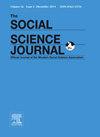Social disorganization, collective efficacy, bullying perpetration, and victimization: An empirical test
IF 1.8
4区 社会学
Q2 SOCIAL SCIENCES, INTERDISCIPLINARY
引用次数: 0
Abstract
ABSTRACTThe current study offers a test of social disorganization theory to assess the effects of neighborhood-level factors on bullying perpetration and victimization. The study offers a quasi-replication the Sampson and Groves (1989) model and integrates proxy measures consistent with prior research to test the theoretical framework on bullying outcomes. Data from the National Survey of Children’s Health (NSCH) 2019 were used to analyze a sample of adolescent youth between the ages 12 and 17 (n = 8,584). Multinomial logistic regression analyses were conducted to assess the effects of indicators consistent with social disorganization and collective efficacy on varying levels of bullying perpetration and bullying victimization. Results suggest that indicators of social disorganization (i.e., low-SES, neighborhood decay) increases the odds of bullying perpetration/victimization. Additionally, collective efficacy reduces the odds of both bullying perpetration and bullying victimization. Ecological factors beyond the context of school environments appear to be influential to bullying outcomes.KEYWORDS: Bullying perpetrationBullying victimizationSocial disorganization theoryCollective efficacy Disclosure statementNo potential conflict of interest was reported by the author(s).Data availability statementThe NSCH data used within this study is available upon request from the Data Resource Center for Child and Adolescent Health at: https://www.childhealthdata.org/help/dataset.社会解体、集体效能、霸凌行为与受害:一项实证检验
摘要本研究通过社会解体理论检验邻里因素对霸凌行为和受害的影响。本研究提供了Sampson和Groves(1989)模型的准复制,并整合了与先前研究一致的代理测量来检验欺凌结果的理论框架。研究人员使用2019年全国儿童健康调查(NSCH)的数据来分析12至17岁的青少年样本(n = 8584)。通过多项logistic回归分析,评估社会失组织性指标和集体效能指标对不同程度霸凌行为和霸凌受害的影响。结果表明,社会解体指标(即低社会地位、邻里衰退)增加了欺凌行为/受害的几率。此外,集体效能降低了欺凌行为和欺凌受害的几率。学校环境之外的生态因素似乎对欺凌结果有影响。关键词:霸凌行为霸凌受害社会解体理论集体效能披露声明作者未报告潜在利益冲突数据可用性声明本研究中使用的NSCH数据可从儿童和青少年健康数据资源中心获得:https://www.childhealthdata.org/help/dataset。
本文章由计算机程序翻译,如有差异,请以英文原文为准。
求助全文
约1分钟内获得全文
求助全文
来源期刊

Social Science Journal
SOCIAL SCIENCES, INTERDISCIPLINARY-
CiteScore
4.70
自引率
0.00%
发文量
0
期刊介绍:
The Social Science Journal is the official journal of the Western Social Science Association. The principal purpose of the journal is to publish scholarly work in the social sciences defined in the classical sense, that is in the social sciences, the humanities, and the natural sciences. The research that is published may take a theoretical or speculative model as well as statistical and mathematical. Contributions are welcome from all fields which have relevant and insightful comments to make about the social sciences. The journal also includes a Research Note section which is devoted to supporting scholarly research that is in progress. The journal has a well-established book review section which reflects the academic and intellectual diversity within the WSSA.
 求助内容:
求助内容: 应助结果提醒方式:
应助结果提醒方式:


